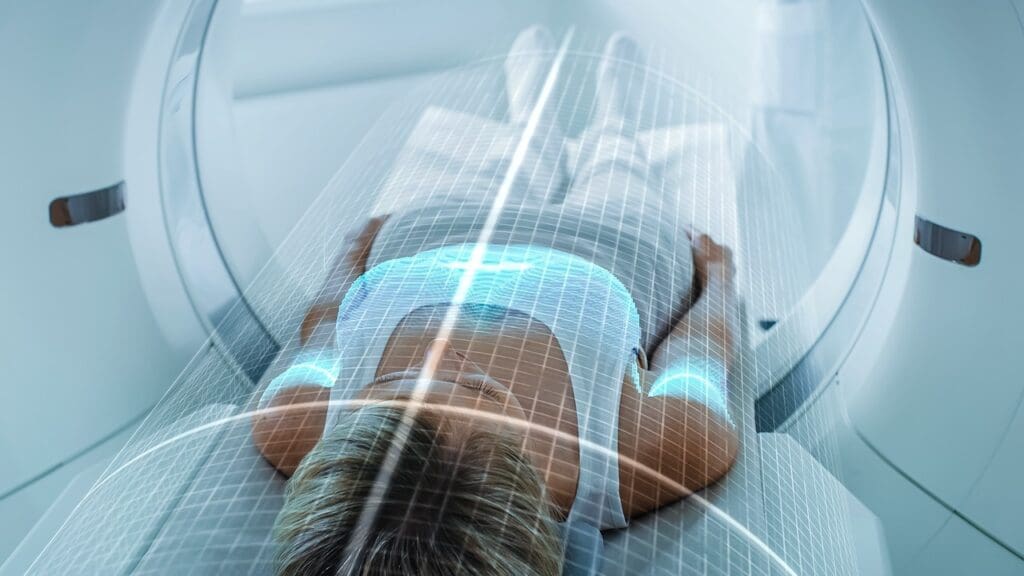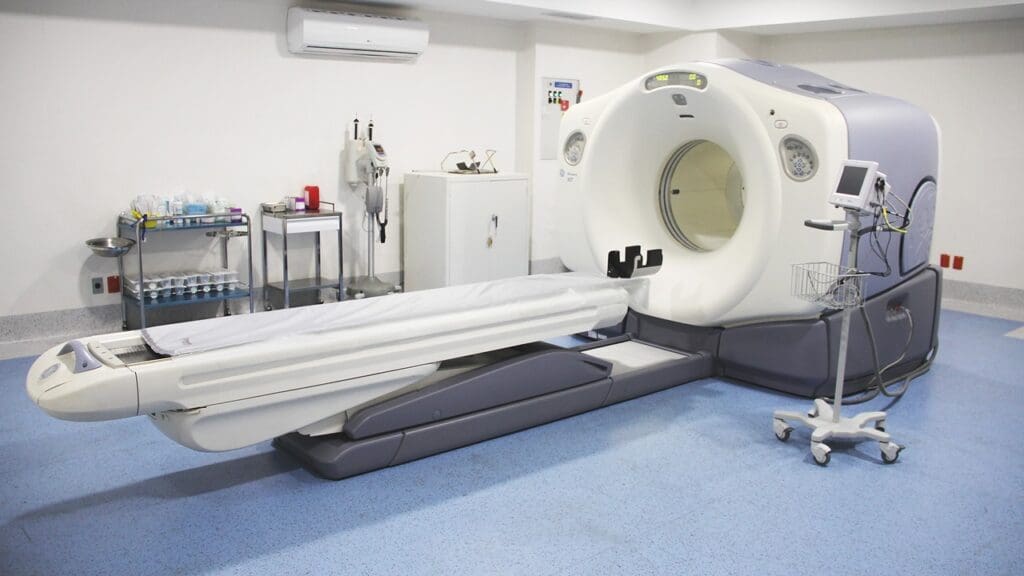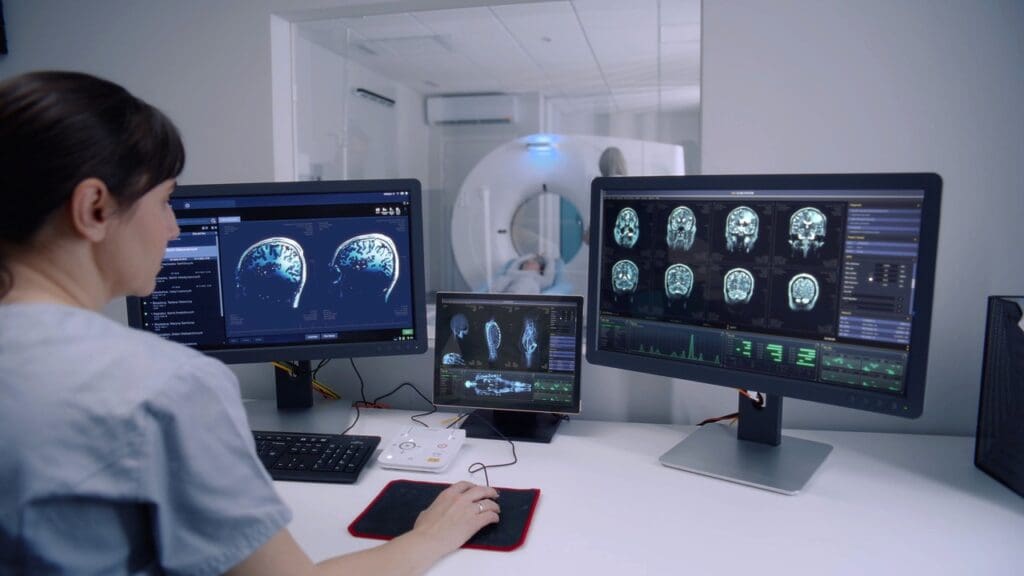What is a PET Scan
A PET scan, or Positron Emission Tomography scan, is a highly advanced imaging technique that helps doctors see how the body’s organs and tissues are functioning. Unlike traditional imaging methods that show only the structure of organs, a PET scan reveals their activity on a molecular level. It works by using a small amount of radioactive tracer that collects in specific areas of the body. This tracer emits signals that are detected by the PET scanner, creating detailed three-dimensional images for accurate diagnosis through PET scan.
At Liv Hospital, diagnosis through PET scan plays a key role in early detection, treatment planning, and monitoring various diseases, particularly cancer, neurological disorders, and heart conditions. The advanced diagnostic imaging center is equipped with modern PET/CT devices that provide precise and fast results, helping specialists design personalized treatment strategies for each patient.

How a PET Scan Works
During a PET scan, a small amount of radioactive substance called a tracer is injected into the bloodstream. The tracer contains a form of glucose that highlights areas of high activity within the body. Since abnormal cells, such as cancer cells, often use more energy, they absorb more of the tracer and appear as bright spots on the scan.
The patient lies on a table that slides slowly through the PET scanner. The device detects radiation from the tracer and produces images of the organs and tissues. In some facilities, including Liv Hospital, the PET scan is combined with a CT scan to merge structural and functional data. This hybrid approach provides exceptional accuracy in identifying disease progression and guiding treatment.
Main Uses of PET Scan
PET scans are most commonly used for detecting and managing:
- Cancer: Identifying tumors, determining whether cancer has spread, and monitoring response to treatment.
- Heart disease: Assessing blood flow and detecting areas of the heart muscle that may not be functioning properly.
- Neurological disorders: Evaluating brain function in conditions such as Alzheimer’s disease, epilepsy, and Parkinson’s disease.
At Liv Hospital, specialists rely on PET scan results to support multidisciplinary treatment planning. Oncologists, cardiologists, and neurologists work together to interpret the findings and decide the most effective therapeutic approach for each patient.
PET Scan in Cancer Diagnosis and Treatment
In oncology, the PET scan is an indispensable tool. It can detect cancer at an early stage before it becomes visible through other imaging techniques. The scan provides information about tumor metabolism, allowing doctors to differentiate between benign and malignant growths.
For patients undergoing cancer treatment, the PET scan helps evaluate how well therapy is working. If a tumor shows reduced activity, it indicates that the treatment is effective. Conversely, if high activity persists, the oncologist may adjust the plan. Liv Hospital’s nuclear medicine team integrates PET scans into every stage of cancer management, from diagnosis to post-treatment follow-up, ensuring accurate evaluation and patient safety.
PET Scan for Heart Conditions
A PET scan can assess how well the heart is functioning by measuring blood flow and oxygen use. It helps identify areas with reduced blood supply and damaged heart tissue. Doctors use these results to plan procedures such as bypass surgery or angioplasty.
At Liv Hospital, cardiac PET scans are used to distinguish viable heart tissue from scar tissue, allowing cardiologists to focus on treatment that preserves healthy heart muscle. This makes the procedure vital for preventing unnecessary interventions and improving patient outcomes.
PET Scan for Brain and Neurological Disorders
The brain consumes large amounts of glucose for energy. PET scans detect abnormal metabolic activity in the brain, making them extremely valuable for diagnosing neurological disorders. In Alzheimer’s disease, for example, specific brain regions show decreased activity. PET imaging can detect these patterns even in early stages, enabling timely medical intervention.
Liv Hospital’s neurology department uses PET scan results to analyze cognitive decline, seizure foci in epilepsy, and brain abnormalities in Parkinson’s disease. The high-resolution imaging supports precise diagnosis and targeted therapy.

Preparation for a PET Scan
Before the scan, patients are typically asked to avoid eating or drinking for several hours. The goal is to keep blood sugar levels stable, as elevated glucose can interfere with the tracer’s accuracy. Patients should inform the medical team about any medications or medical conditions, especially diabetes or pregnancy.
The staff at Liv Hospital ensures that every patient receives personalized preparation instructions based on their health profile. Comfort, safety, and accuracy are the top priorities during the entire process.
What Happens During the Procedure
The PET scan procedure usually takes between 30 and 60 minutes. After the tracer is injected, there is a waiting period to allow it to distribute throughout the body. The patient then lies down on a scanning bed that moves through the PET machine.
The procedure is painless and noninvasive. Patients are advised to stay still during the scan to ensure clear images. Once completed, the radiology team reviews the images for quality before forwarding them to the specialist. Liv Hospital provides a calm and reassuring environment, reducing anxiety and ensuring that patients are comfortable throughout the scan.
Interpreting PET Scan Results
After the scan, a nuclear medicine specialist or radiologist analyzes the images to detect abnormalities in metabolic activity. Areas that absorb more tracer often indicate high cellular activity, which could suggest cancer or inflammation. Areas that absorb less may indicate reduced function or tissue damage.
Liv Hospital’s specialists interpret the results in the context of each patient’s medical history and clinical condition. The findings are shared with the referring physician, who uses them to develop a personalized treatment plan.
Benefits of PET Scan
PET scans offer several advantages over other imaging techniques:
- Early detection of disease before physical changes occur
- Accurate differentiation between healthy and abnormal tissues
- Effective monitoring of treatment response
- Guidance for surgical and radiation therapy planning
At Liv Hospital, PET scan technology represents the hospital’s commitment to precision medicine. By combining advanced imaging with multidisciplinary expertise, patients receive care that is both efficient and deeply personalized.

Risks and Safety Considerations
Although PET scans involve exposure to a small amount of radiation, the dose is very low and considered safe for most patients. The tracer is quickly eliminated from the body, usually within a few hours. Patients are encouraged to drink plenty of fluids after the scan to speed up the process.
Liv Hospital follows international safety standards and employs advanced protocols to minimize radiation exposure. The medical team monitors each patient carefully to ensure optimal safety and accurate results.
Recovery and Aftercare
After a PET scan, most patients can resume normal activities immediately. Drinking water helps flush out the tracer, and no special recovery period is needed. Doctors may schedule a follow-up appointment to discuss the results and determine the next steps in treatment.
Liv Hospital provides post-scan consultations where radiologists and specialists review findings with patients in detail. This collaborative approach ensures transparency and helps patients understand their condition clearly.
The Future of PET Scan Technology
PET scan technology continues to evolve rapidly. Innovations in tracers and hybrid imaging systems are increasing the accuracy and efficiency of diagnosis. Artificial intelligence and machine learning are also being integrated to enhance image interpretation and predictive analysis.
Liv Hospital is at the forefront of adopting these technological advancements, ensuring that patients benefit from the most sophisticated diagnostic tools available. The ongoing improvements in PET scan technology promise earlier detection, improved treatment outcomes, and a new era of personalized medicine.
Why Choose Liv Hospital for PET Scan
Liv Hospital combines cutting-edge technology, expert medical teams, and compassionate patient care. The hospital’s nuclear medicine department is equipped with modern PET/CT scanners that deliver clear, precise images with minimal radiation.
The multidisciplinary collaboration between oncologists, cardiologists, neurologists, and radiologists ensures that each PET scan result is analyzed comprehensively. Patients receive timely reports, accurate diagnoses, and tailored treatment strategies that reflect Liv Hospital’s dedication to quality healthcare.
* Liv Hospital Editorial Board has contributed to the publication of this content .
* Contents of this page is for informational purposes only. Please consult your doctor for diagnosis and treatment. The content of this page does not include information on medicinal health care at Liv Hospital .
For more information about our academic and training initiatives, visit Liv Hospital Academy
Frequently Asked Questions
What does a PET scan show?
A PET scan shows how organs and tissues are functioning at a cellular level, not just their structure.
Is a PET scan painful?
No, the procedure is painless and noninvasive, involving only a small injection for the tracer.
How long does a PET scan take?
The entire process usually takes about one to two hours, including preparation and scanning time.
Are there any side effects after a PET scan?
Side effects are rare, but mild fatigue or discomfort at the injection site may occur briefly.
Can I eat before a PET scan?
You may need to fast for several hours before the scan. The medical team will provide specific instructions.
Is a PET scan safe for everyone?
Yes, it is safe for most people. However, pregnant or breastfeeding women should inform their doctor beforehand.
How often can I have a PET scan?
The frequency depends on your medical condition and treatment plan, as decided by your doctor.
What is the difference between a PET and CT scan?
A CT scan shows anatomy, while a PET scan shows metabolic activity. When combined, they offer complete diagnostic insight.
When will I get the results?
Results are typically ready within a few days and reviewed by your doctor to plan the next steps.
Why should I choose Liv Hospital for a PET scan?
Liv Hospital provides state-of-the-art imaging, expert interpretation, and a comfortable patient experience from start to finish.